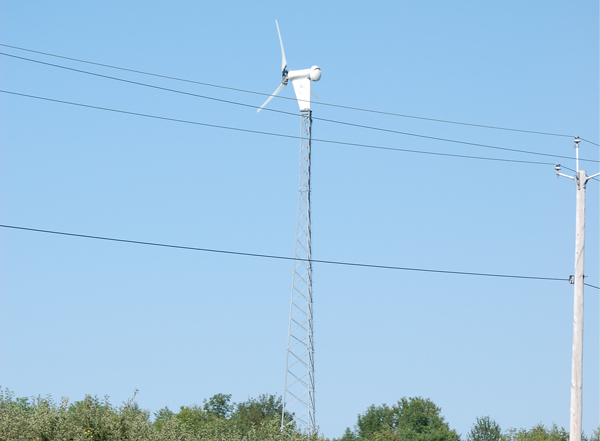

Dec 20, 2010Wind energy pays for itself – eventually
Windmills used to be a sign of farming, especially on the plains, where they were used to power pumps to bring water up from wells for homes, crops and animals. Today’s modern windmill spins a turbine to generate electricity.
Modern windmills are a viable energy option for growers, according to the New York State Energy Research and Development Authority (NYSERDA). Grants and low-interest loans are available from state and federal agencies to defray some of the massive costs of installing alternative energy sources on the farm.
The cost to install a wind turbine is between $6 and $10 per kilowatt of the turbine, said Mark Mayhew, project manager of NYSERDA’s Wind Incentive Program.
“I realize this is a huge range, but the peculiarities of the site have a big impact on cost,” he said.
Those peculiarities include terrain, distance from road, distance from power supply and soil type. A 10-kilowatt system will cost about $75,000, Mayhew said.
“Proper sitting of a wind turbine is extremely important for a turbine to make economic sense.”
Chip and Karla Bailey own KC Bailey Orchards in Williamson, N.Y. They were looking at ways to cut costs for building a cold storage facility, and electricity was a major expense. After a nine-year process that included countless hours of research and working with local planning boards, they brought a windmill online this past summer. It provides power to a storage facility, labor camp and small shop.
“The windmill doesn’t provide 100 percent of the electricity we use, but it is close,” Karla said. “We’re still monitoring it, but we’ve only received two electric bills since we set it up.”
Research led Chip to believe they were in a good area for wind, with peak winds from September through May – which met his needs for a cold storage facility.
USDA offers grants and low-interest loans to help defray the majority of the cost. States like New York have similar programs, and can work with USDA to offer even more assistance.
The NYSERDA Customer-Sited Wind Turbine Incentive Program provides up to $400,000 per turbine, which can be paid to eligible installers. The installer must install approved, grid-connected wind-energy systems using qualified equipment, in accordance with the eligibility requirements. The maximum equipment size allowable under these guidelines is a windmill generating 600 kilowatts per site/customer. The NYSERDA incentive will not exceed 50 percent of the total installed cost of the system, leaving the grower to obtain the rest of the financing.
“Our new program has been open for just over a month,” Mayhew said. “In that time we received 11 applications, and eight were from farmers. For the last program, in the past three years, we received 60 applications and 18 were from farmers.”
They’ve hit a perfect storm with USDA-REAP grants, 1603 tax credits and NYSERDA’s incentive to make turbines affordable, he said.
Depending on where you live, the windmill can be routed into your electric grid. In the case of New York, the utility company is required by law to buy the excess energy from you. In other words, the electric company has to pay you for the energy you don’t use. Over time, this means the system will pay for itself and then some.
“Farmers will see a decrease in their electric bill the first month after installation,” Mayhew said. “In general, wind turbines are a long-term investment. A typical payback would be 10 to 15 years, but with tax credits, depreciation and a good, consistent, strong wind, the payback can be in the five- to 10-year range.”
When the Baileys set criteria for their windmill, they looked at numbers with a payback of 10 years or less. The payback had to be sustainable, too, Chip said.
“When we plant our trees and set up our orchards, we look at the land, the sun and the prevailing winds,” Karla said. “We think about these things on a daily basis. It is a natural fit for growers to look at alternative energy sources.”
“It is also a great way for small business owners to leverage their time,” Chip said.
– Derrek Sigler














